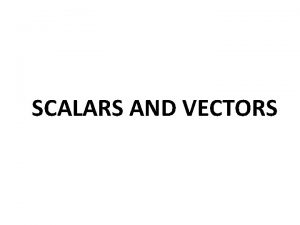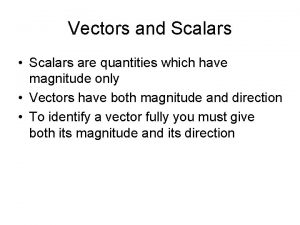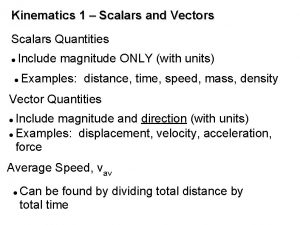Scalars and Vectors Lecture 2 All physical quantities



- Slides: 3

Scalars and Vectors Lecture 2 All physical quantities in engineering mechanics are measured using either scalars or vectors. Scalar. A scalar is any positive or negative physical quantity that can be completely specified by its magnitude. Examples of scalar quantities include length, mass, and time. Vector. A vector is any physical quantity that requires both a magnitude and a direction for its complete description. Examples of vectors encountered in statics are force, position, and moment. A vector is shown graphically by an arrow. The length of the arrow represents the magnitude of the vector, and the angle θ between the vector and a fixed axis defines the direction of its line of action. The head or tip of the arrow indicates the sense of direction of the vector.

I- Resultant Of Two Forces by Graphical method Procedure for Analysis 1. Parallelogram Law. • Two “component” forces F 1 and F 2 in Fig. (a) add according to the parallelogram law, yielding a resultant force FR that forms the diagonal of the parallelogram. • If a force F is to be resolved into components along two axes u and v , Fig. (b) , then start at the head of force F and construct lines parallel to the axes, thereby forming the parallelogram. The sides of the parallelogram represent the components, Fu and Fv. • Label all the known and unknown force magnitudes and the angles on the sketch and identify the two unknowns as the magnitude and direction of FR , or the magnitudes of its components. 2. Trigonometry. • Redraw a half portion of the parallelogram to illustrate the triangular head-totail addition of the components. • From this triangle, the magnitude of the resultant force can be determined using the law of cosines, and its direction is determined from the law of sines. The magnitudes of two force components are determined from the law of sines. The formulas are given in Fig. (c).

Example: The screw eye in Fig. is subjected to two forces, F 1 and F 2. Determine the magnitude and direction of the resultant force.





